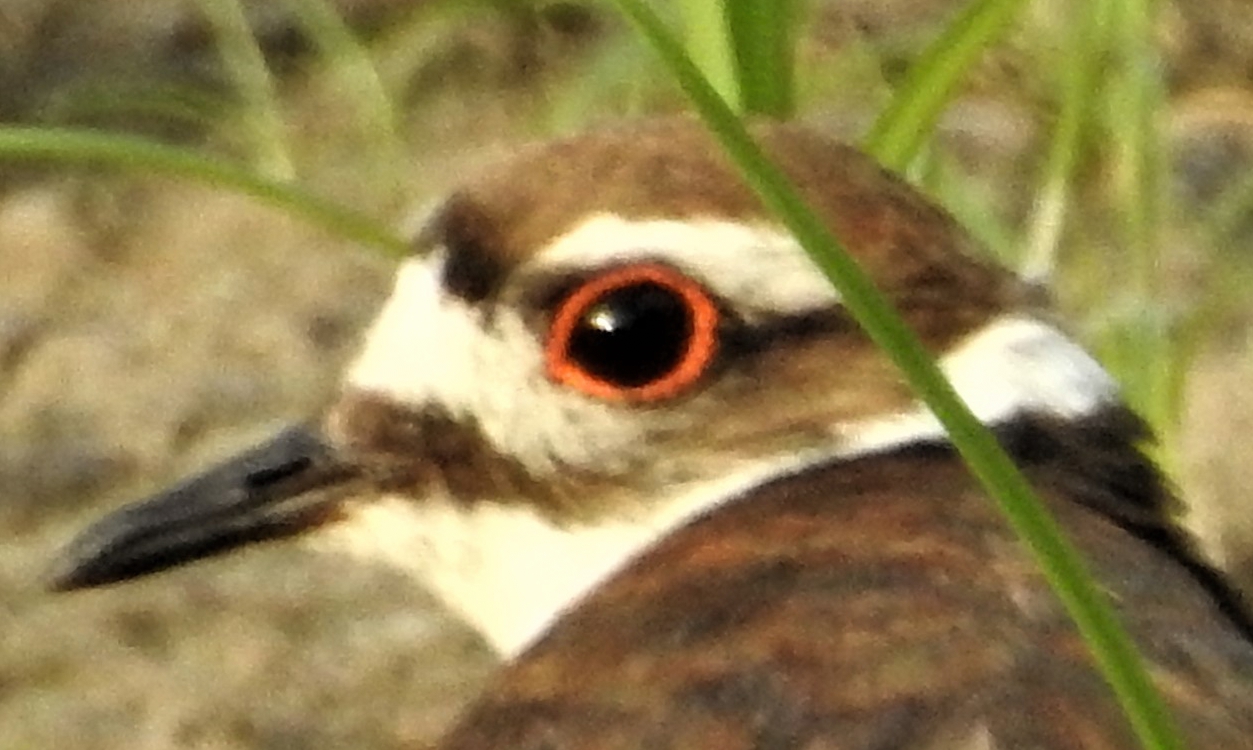by M. Kathy Raines

A reedy, insistent whine of “Kill-dee!” alerted me to this handsome plover with its roundish head, signature double breast bands and dark, massive eyes ringed with flaming orange.
Pacing the shallows of a receding resaca, this plover, a killdeer—so-named for its namesake cry—probed the mud with its pointed beak, then halted, head bobbing, to study its environs—including me. Then it repeated its pattern—typical killdeer behavior. This steadfast bird may flutter off when discomfited, but rarely far away.
A killdeer probes the soil for invertebrates—earthworms, snails and insects—but it may also, shake, wash and swallow a green tree frog. The bird may follow a plow, then dine on unearthed grubs. With its foot, it may pat watery mud, presumably to squeeze out any inhabitants.
The killdeer sports stripes across its face, forehead and above its bill. Vivid orangish-red skin encircles the eyes of adults, while juveniles wear lighter, yellowish rings. It has an orangish rump, especially noticeable when aloft, and a long tail and wings, which assist in maneuverability. The sexes look similar, but juveniles bear only one breast band.
In the 1700s, settlers called this voluble killdeer (Charadrius vociferous) “chattering plover” or “noisy plover”.
Killdeer tolerate various habitats, including fresh and saltwater shores and mud flats, but also—unlike their fellow plovers—lawns, roofs and even parking lots. They live year-round throughout the southern and lower Midwest and Southwest, extending to South America. They breed as far north as mid-Canada. Those living in cool climates migrate before winter, returning as early as February or March.
They sleep in open areas—on the ground, on rooftops, often with other shorebirds—retreating, if needed, under bridges and into barns.
After claiming territory, a male makes a persistent two-note call to entice a mate. He also soars above the potential nesting area, appearing to float unsteadily, calling out, “Kill-dee!” Together, a pair scrapes out a nest on the ground, but sometimes on a rooftop, rotting log or gravel pile. Killdeer may create several nests, perhaps to baffle potential predators.
Both parents incubate their four or five eggs. During scorching weather, a killdeer may stand, shading the eggs with its feathers. It may also soak its belly thoroughly, then drizzle eggs with water.
A killdeer uses several ploys to protect its unshielded nest. Famously, it makes itself a decoy by feigning a broken wing. The bird lands suddenly, lifting one wing and banging the other on the ground, sometimes dragging it in the dirt, while leading a predator yards away from the well-camouflaged nest. Then—surprise!—the spunky killdeer flies away. Also, a killdeer may sit upon an unused scrape, pretending it’s a nest. This apparently repels birds and humans from its genuine nest, but mammalian predators appear wise to this diversion.
Interestingly, the preen oil of killdeer and other ground nesters becomes odorless during nesting season, which masks their smell from coyotes, foxes and skunks.
As soon as they hatch, fluffy, toothpick-legged chicks scurry along to feed with their parents—a risky operation when they descend from rooftop nests. Born swimmers, newborns have crossed small streams. Eggs usually hatch within the hour, but if not, one parent shepherds the first batch, while the other awaits any stragglers.
Killdeer, once in decline, appear to be thriving in most parts of their range, despite human encroachment. However, being susceptible to chemical pollutants, oils and pesticides, they require protection. Researchers monitor this successful plover to better understand its threatened relatives like the piping plover.


